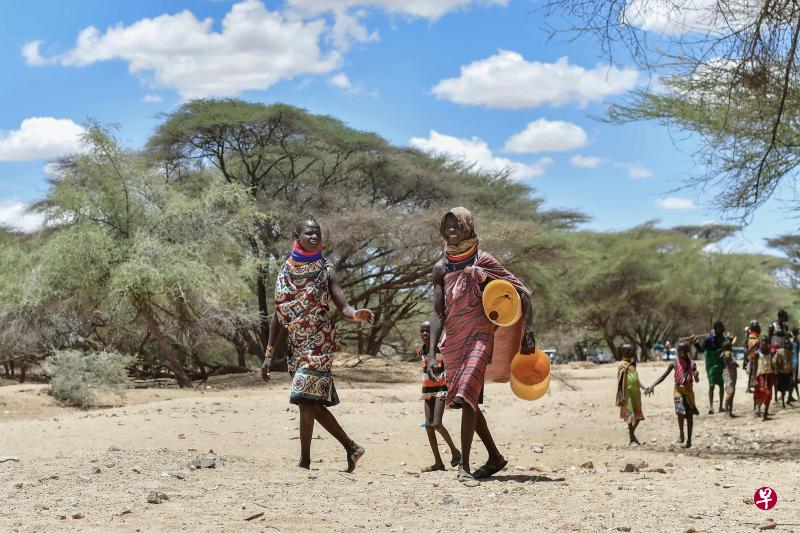
International
Special
The global population is increasing rapidly every day, but there are many problems to deal with this world. There are many imminent crises, and they have not been able to take care of it.
The population consumption of global resources is definitely larger and larger. If it goes on, this hidden chronological bomb always has a day of explosion.
Take a closer look at the global population data and predictions of the United Nations, which will be startled.
The United Nations Ministry of Economic and Social Affairs on July 11 The 2022 World Popular Population Outlook on the World Population Day said that the global population will reach 8 billion on November 15 this year.The report predicts that India will surpass China next year and become the country with the largest population in the world.
Experts point out that after hundreds of thousands of years, the population of the earth has only reached 1 billion.In 2011, the global population was 7 billion, only 11 years, an increase of 1 billion.
According to this trend, it is estimated that by 2030, the global population will increase to 8.5 billion in eight years, from 2050 to 9.7 billion, and exceed 10 billion by 2100, reaching 10.9 billion.
More than half of the global population lives in seven countries.In addition to China and India, which have more than 1.4 billion population, the countries with the most population followed by followed by the United States, Indonesia, Pakistan, Nigeria, and Brazil.The population of China or India alone is equivalent to the total population of all countries in Africa, which easily exceeds the total population of more than 700 million or more than 1 billion in the Americas.
At the same time, the population has become more and more serious for decades, and many of them are developed economies such as Europe and Japan.
The United Nations is expected to be reduced by 55 countries or regions around the world by 2050. Among them, Bulgaria, Croatia, Hungary, Japan, Latvia, Lithuania, Romania, Serbia, and Ukraine will be reduced by 2050%above.From now to 2050, Africa will be the fastest -growing mainland.
With the growth of the population, the world's hungry population has increased year by year.The United Nations Food and Agricultural Organization pointed out a few months ago that nearly 800 million people were affected by hunger in 2021, accounting for nearly 10 % of the global population.This number increased by 46 million compared with 2020, an increase of 150 million people over 2019.
There are many countries with a large population, mostly in developing countries, have more fertility, unable to afford it, and form a vicious circle.Children in developing countries are common problems.
UNICEF pointed out in September that Somalia, Africa will have more than 500,000 children under 500,000 this year, facing the risk of serious malnutrition and death in famine, and warned that this century has never been in any country in this century.Severe situation.
Droughts occur from time to time in the corner of Africa, and famine occurs in some areas of Somalia, and it is estimated that it will be more serious than the famine in 2011.The famine 11 years ago caused more than 250,000 people in Somalia, most of which were children.Now, the nutritional center of Somalia is no longer losing, and the UNICEF spokesman Eld said that even babies in the center can only be placed on the floor for treatment.
The Uganda climate activist Vanessa Nakate, who was appointed by the UNICEF Ambassador, went to Kenya to learn about children's malnutrition in September in September.What Nakkart didn't expect was that she witnessed a tragedy on earth.Nakkart said shocked: "This drought, I encountered many children with serious acute malnutrition. I met a child that day, but he did not expect that he was dead the next morning."
United Nations: Population problem challenge
UNICEF said that about 1 billion children in the world lived in 33 countries that are classified as "extremely high risks" due to climate change.
Humans face so many problems and need long -term response plans.The United Nations has proposed the millennium development goals many years ago. By 2015, the UN General Assembly formulated sustainable development goals (see tables) replacement, and strive to achieve it in 2030.There are 17 sustainable development goals, covering various aspects such as society, environment and economy, and aiming to be a shared blueprint for the peace and prosperity of human beings and the earth in the future.
Bela Hovy, Director of the Immigration Department of the Ministry of Economic and Social Affairs Department of Economic and Social Affairs, accepted an interview with Lianhe Zaobao email: "The continuous high fertility rate and rapid population growth are"Health care and high -quality education have formed challenges. The rapid population growth may also lead to environmental degradation and affect climate change. "
To control population growth, family planning is still important.Facts have proven that countries with high proportion of women with contraceptive measures generally have a low fertility rate.
Huowei is also an expert in population.He said that in order to achieve the decline in the expected fertility rate, the existing long -term plans should be continued, such as the realization of gender equality, giving women power, and eliminating all violence and discrimination against women.
AListair Currie, a spokesman for the British think tank and charitable group Population Matters, was interviewed by Lianhe Morning News that many current problems are merging into crisis, so that short -term and long -term problems must be solved at the same time.
Curi said: "The good news is that we have recently seen a lower population forecast, which indicates that the road to the sustainable population is expected to be realized faster. Bad news is that it still needs us to continue to accelerate action."
Popuration Matters is committed to solving the population scale and this impact on environmental sustainability.It believes that population growth is the main factor that leads to environmental degradation, loss of biological diversity, resource exhaustion and climate change. This organization has increased people's attention to population problems through lobbying and propaganda for many years.
Curi said that looking at the current situation, there is still a long way to achieve the goal of sustainable development worldwide, "and" we are actually backward on the human development index. "
Civil institutions: International ignore the impact of population growth
The current war, energy crisis, and food crisis that appears have made countries take care of themselves.Can the United Nations and other international institutions play a role in alleviating population problems?
Huo Wei told Lianhe Zaobao that population growth usually does not lead to conflict or crisis.The major institutions of the United Nations Security Council to deal with peace and security issues.
He said that the main task of the United Nations is to support member states to achieve sustainable development goals in 2030, including reducing mortal mortality and mortality in children under five years old.
Improve education level is another major task.Huo Wei saidWhen the size of the family is reduced, the children raised by the couple are reduced, and the education of each child is naturally more.This allows the next generation to have the opportunity to receive better education, and it will help improve or improve their lives in the future.
Huo Wei also said that reducing the number of pregnancy and premature fertility, so that women will not interrupt their studies in their youth. From the perspective of the long -term development of society, it will help reduce the percentage of women and children living in poverty.
Curi said that the international community does not think that population growth is one of the guides in the face of many problems in the face of many problems, which makes him wondering.
Curi believes that the United Nations and other international institutions do not do enough on population issues. He mentioned that the Special Committee (IPCC) of the United Nations Intergovernmental Climate Change has determined the population growth as one of the two main reasons for emissions, but it did not propose the corresponding specific specific specific specificationss solution.
Curi noticed that IPCC's climate change report in 2022 mentioned that globally, the per capita GDP and population growth are still the strongest driving factor for fossil fuel carbon dioxide emissions in the past 10 years.From 2010 to 2019, the per capita GDP and population growth increased by 2.3 % and 1.2 % year -on -year, respectively.
Population problems affect global economic growth
The population problem involves all aspects and launching the whole body, it will have a wide range of impacts and related to each other.
UNITED National Population Fund Economics and Popular Senior Advisor Michael Herrmann proposed three possible macro solutions: 1. Use the population data to make a good plan in advance, and establish a full toughness.Third, the people -oriented population policy is implemented.
Herman said that countries must systematically evaluate population changes."If you don't understand the population, age and residence, and how the population, age structure and space distribution will change, countries will not understand the current and future demand of the country. If there is no population statistical insight, whether you can formulate effective policies, it will be effective.It is a problem of luck rather than a design problem. "
He pointed out that to meet the global population demand and improve living standards, it will require a higher level of production, which will bring greater consumption.
"But if there is no green reform in energy, manufacturing and transportation, and changes in human behavior, this will cause increasing pressure on the natural environment."
How does the global population affect economic development?Andrew Mason, a professor of economics at the University of Hawaii and a senior researcher at the Eastern and Western Center of Education and Research, said in a joint research report that population changes will have a profound impact on the country, region and global economy. For individual countries,It means that the government must invest more resources to alleviate the impact of population aging, thereby pushing up public debt.For the global economy, it is estimated that global GDP growth in the next decades may slow about 1 percentage points each year.
He said that the era of population -driven economic growth is about to end.Population growth should promote the continued growth of global GDP, but because the growth of labor age population is concentrated in countries with low labor productivity, it has little effect.
Thereport pointed out that the "population transformation" initially caused the global population to grow to the unprecedented level in the early 1970s.That is, the rapid population growth has caused the number of workers to increase rapidly, and the expansion of the workers' group has promoted the rapid economic growth.When the population transition is over, the future population will grow slowly.Population transformation generally refers to the economic system before an industrialization of a country or region to the industrialized economic system. It is often accompanied by the phenomenon of high birth rate and high mortality rate, transition to low birth rate and low mortality.
United Nations: If the war continues to face the global shortage of food next year
Now is a turbulent period.The Great Power Game (Sino -US wrestling), the Russian and Ukraine War (US -Russian wrestling), affecting the world.
International agencies have warned that this year is the dispersion of grain affected by the crown disease, war and supply chain, and next year is likely to be a crisis of food shortage.This is because the war interrupted the exports of food and fertilizers in Russia and Ukraine, pushing up global food prices, and obstructing the sowing of Ukraine farmers.The United Nations warns that the shortage of chemicals this year is fertilizer. If the war continues, the shortage of next year will be food.
Once such a situation occurs, the poor country will be the first and serious famine.Those countries that have been hit by natural disasters such as drought will be more unsustainable and will also be more likely to occur.The Spring of Arabia 12 years ago was from the civil changes caused by the shortage of food. As a result, there was a bone -style political collapse in many countries in North Africa. Today, the chaos has not subsided. In the end, it is the civilians that suffer.
50 countries around the world rely on Russia and Ukraine
Georgieva, director of the International Monetary Fund (IMF), just warned that global food issues continued to deteriorate this week. Nowadays, as many as 48 countries are facing the grain crisis, and half of the situation is fragile.What is worrying is that there are more than 141 million people in the Arab world insufficient food.UN trade statistics show that 50 countries around the world rely on wheat in Russia and Ukraine, and the Arab world is highly dependent on Russia and Ukraine exports.
Except for food, another everyone feels high inflation.The soaring inflation rate has caused tension in many countries, and countries that have been managed well have worsened.For example, the financial crisis broke out in Sri Lanka and evolved into a political crisis. The former president fled, and the new government came to power, but no one could resolve the crisis and the people continued to live in the deep water.
Iran has frequently appeared in the past two or three years of people's demonstrations. Recently, a young woman was accused of violating the rules of wearing a headscarf and was detained by the moral police.The family and people of the deceased believed that she was beaten to death, and the incident triggered a national demonstration protest nationwide. Many women expressed their dissatisfaction by taking off their headscarves, hair cutting and burning headscarves in public.The angry Iranians also demanded that the highest leader Hamenei stepped down, which was incredible in the past, indicating how tense Iran's internal situation was.
Nowadays, the arms competitions of large countries and powers have become more intense, which has become another instability that affects global security.
Sweden Stockholm Institute of International Peace (SIPRI) issued a report in May that before the war of Russia and Ukraine, the global military expenditure in 2021 rose for seven consecutive years to more than 20 trillion US dollars (about 286 trillion yuan S $ 2.86 trillion) New high.
The military confrontation between the United States and NATO and Russia has continued, especially in Europe's military expenditures in the future.The United States, China, India, Britain and Russia are currently the top five military expenditures, and military expenses in Japan and Australia are also increasing.
In this situation, how can various countries have spare no effort to care about population issues?



